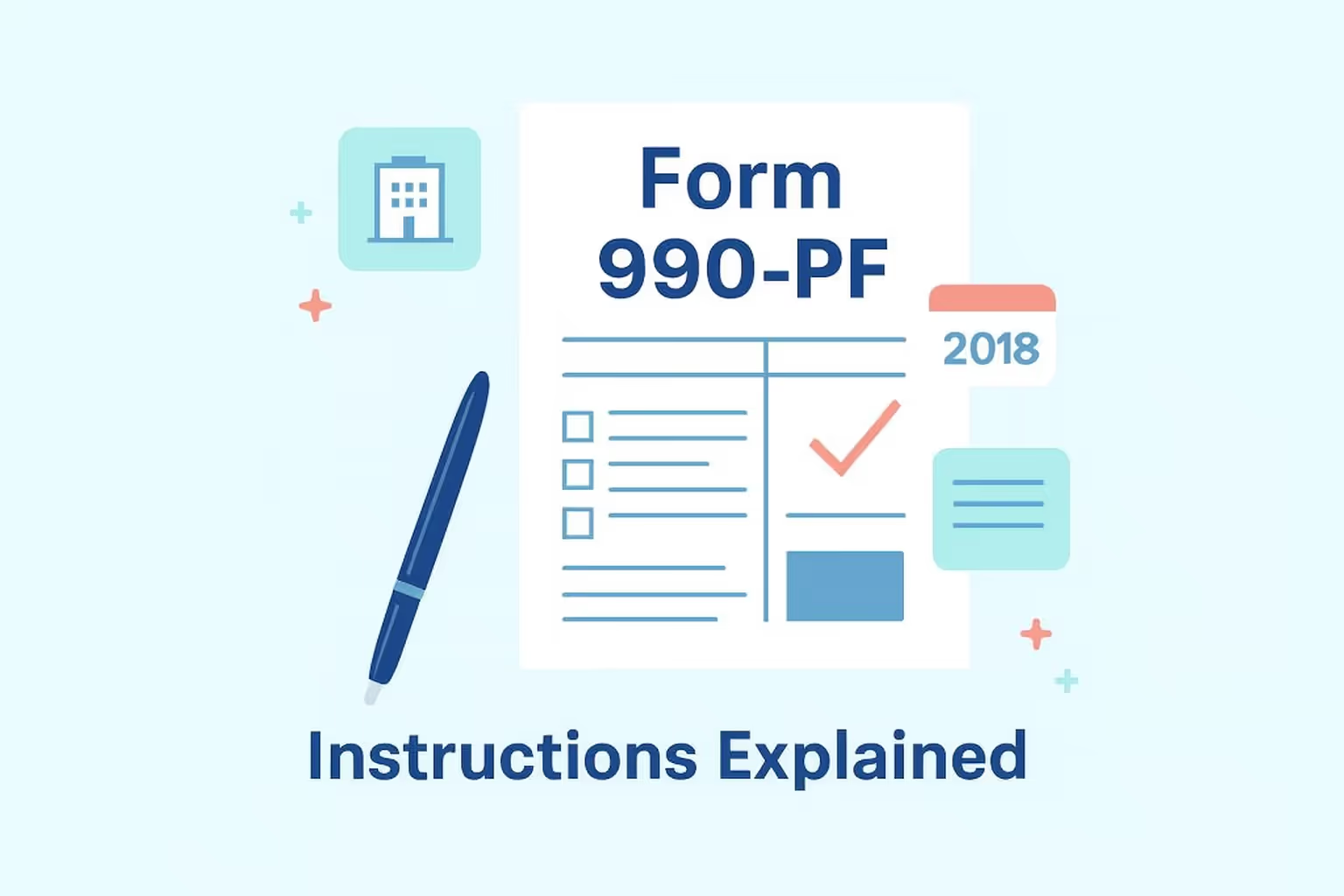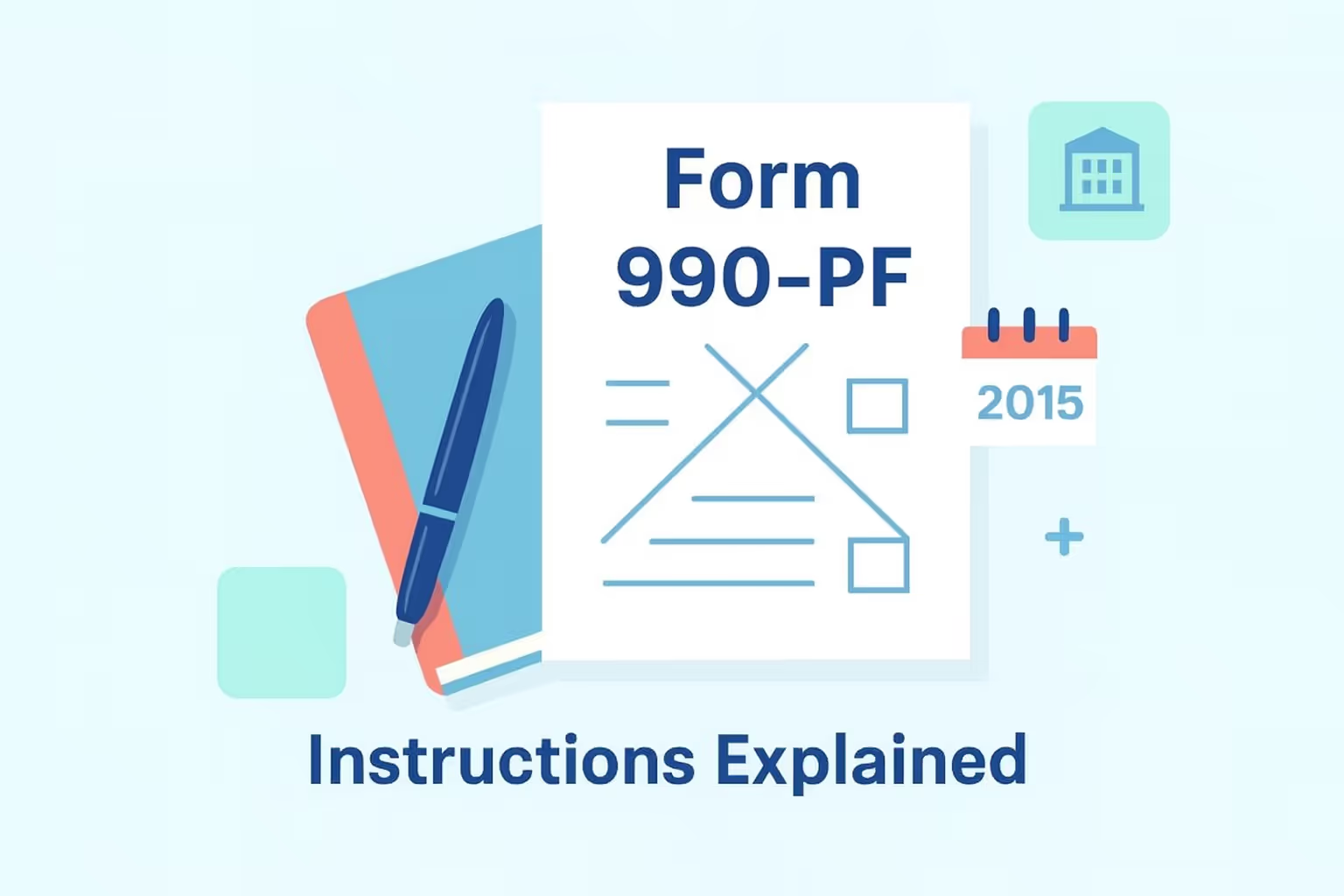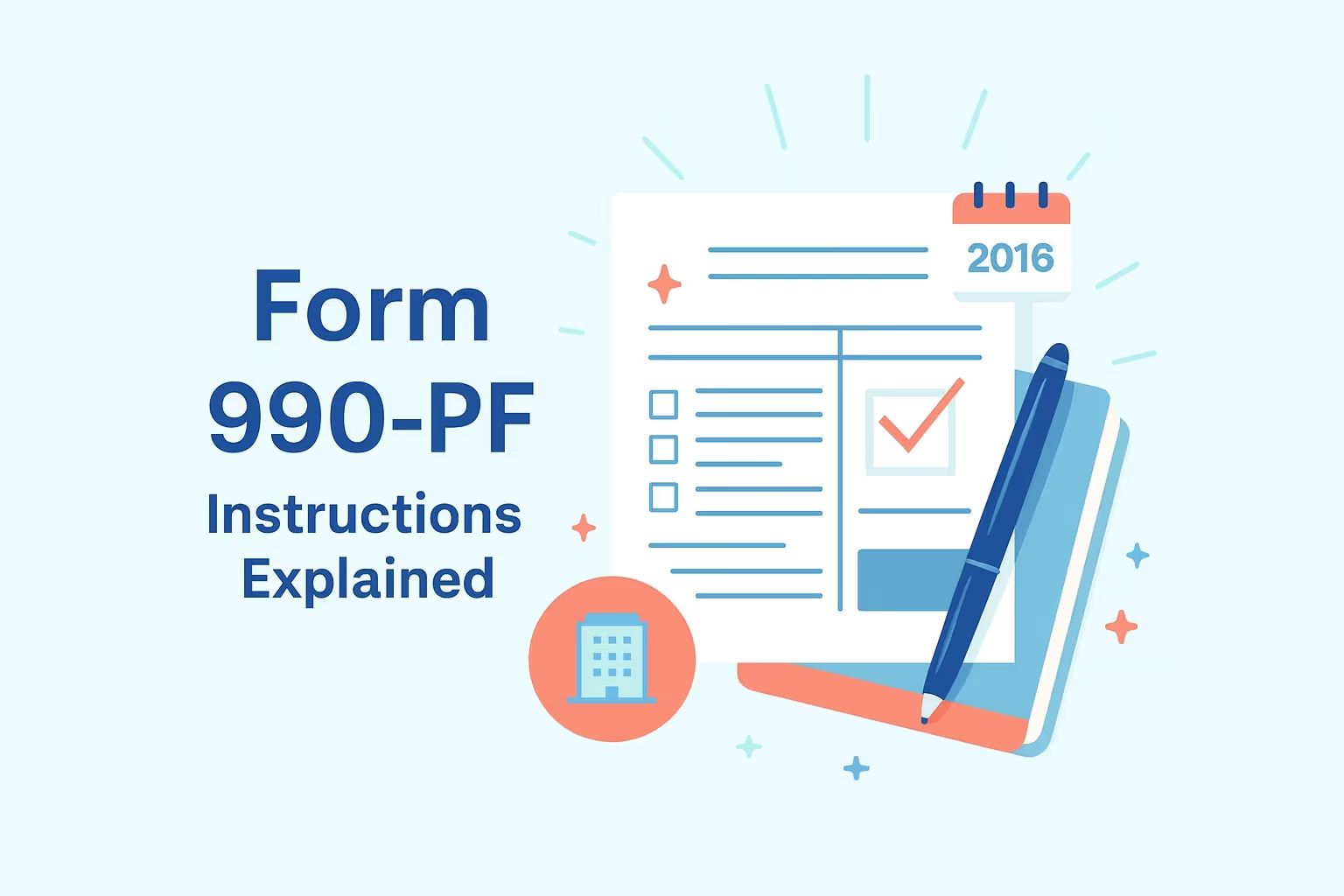Filing Form 990-PF for tax year 2023 can feel overwhelming for private foundations, particularly for those new to federal income tax reporting. The form applies to tax-exempt organizations that fall under private foundation rules, including taxable private foundations and nonexempt charitable trusts treated as private foundations. The Internal Revenue Service requires this return to provide transparency about a foundation’s financial holdings, gross income, and excise tax-based obligations. Understanding these details early helps reduce reporting errors and makes the process more straightforward.
The 2023 filing process requires organizations to carefully report net assets or fund balances, fair market value of investments, temporary cash investments, and operating and administrative expenses. The form also includes disclosures for program-related investments, direct charitable activities, and adjusted net income. Accuracy is critical because any inconsistencies in reporting gross income, undistributed income, or the roles of foundation managers can affect compliance and a foundation’s tax-exempt status. Many organizations also need to account for excess business holdings, personal benefit contracts, or other special categories of income-producing activities.
Form 990-PF also determines excise tax based on net investment income, monitors minimum investment return requirements, and ensures that private foundations meet qualifying distribution rules. This guide will break down each section into clear explanations, covering required records, accounting method choices, and how to report federal income tax details. By following step-by-step guidance, private foundations can file with greater confidence and maintain their tax-exempt status.
Private Foundations and Who Must File
Private foundations differ from public charities in that they typically rely on funding from a single donor, family, or corporation. The IRS requires these entities to file Form 990-PF annually to disclose assets or fund balances, report excise tax based on investment income, and maintain their tax-exempt status. Filing obligations apply regardless of size, activity, or distributions made during the year.
Entities Required to File
- Exempt private foundations under section 501(c)(3): Funded by one primary source, most often making grants to other nonprofits. These foundations are primarily funded by a single source and typically make grants to other nonprofits.
- Taxable private foundations: These organizations have lost their exempt status but still retain their foundation classification for reporting purposes.
- Nonexempt charitable trust treated as a private foundation: These trusts function like foundations and must file until an exemption is granted.
- Organizations claiming private foundation status: These are new entities with pending exemption applications.
- Other domestic foundations or foreign foundations: These entities hold investments or maintain operations tied to the United States.
Information That Must Be Reported
Every foundation must disclose gross income, net income, adjusted net income, and fund balances. They must also include details on temporary cash investments, capital gain net income, program-related investments, and qualifying distributions. These items allow the IRS to calculate compliance with the minimum investment return and excise tax rules.
Governance and Oversight
Foundations must identify foundation managers, officers, directors, trustees, highly paid employees, and anyone with substantial influence. They must also disclose compensation, administrative expenses, and other organizational expenditures. Proper reporting ensures that funds are dedicated to charitable activities rather than being used for prohibited tax shelter transactions or unrelated business income.
Compliance Importance
Organizations classified under the IRS definition of private foundations, including nonexempt charitable trusts and entities claiming foundation status, are required to complete this filing as described in official Form 990-PF guidance. Accurate reporting preserves nonprofit exemption, promotes accountability, and strengthens public confidence in operations.
Filing Requirements and 2023 Updates
Every private foundation is required to file Form 990-PF annually, regardless of its size, activity level, or asset holdings. The IRS enforces this requirement to ensure transparency and accountability for all tax-exempt organizations operating under private foundation rules. Timely filing supports compliance with federal income tax laws and preserves the foundation’s tax-exempt status.
Filing Rules for 2023
- Annual Filing Obligation: All private foundations, including taxable private foundations and nonexempt charitable trusts, are required to submit Form 990-PF each year.
- Deadline Based on Tax Year: Foundations following a calendar year must file by May 15, while those following a fiscal year must submit five months after the end of their fiscal year.
- Extension Through Form 8868: An automatic six-month extension is available; however, any required tax must still be paid by the original deadline.
- Information to Include: Organizations must report their fund balances, adjusted net income, gross income, and program-related investments in detail.
Key Updates for the 2023 Form
- Excise Tax-Based Change: The rate on net investment income remains at 1.39 percent following the reforms, replacing the prior two-tier system.
- Net Asset Reporting Standards: Updated guidance requires classifying net assets or fund balances with and without donor restrictions, aligning with the Financial Accounting Standards Board's rules.
- Mandatory Electronic Filing: Every foundation is required to submit Form 990-PF electronically. This rule applies to all foundations regardless of asset levels.
- Schedule and Form Integration: Organizations may need to file related forms, such as Form 4720, for excise tax on prohibited transactions or undistributed income.
Why These Requirements Matter
Meeting these requirements demonstrates that a foundation manages its assets responsibly and directs its resources toward charitable purposes. Transparent reporting of income-producing activities, qualifying distributions, and undistributed income enables the IRS to monitor compliance with minimum investment return rules effectively. Adhering to the updated structure for reporting net assets or fund balances reduces errors and improves transparency in financial disclosures.
Reporting Net Assets, Fund Balances, and Fair Market Value
Private foundations must present a complete financial picture of their operations in Form 990-PF. This includes reporting on net assets, fund balances, and the fair market value of investments. These disclosures demonstrate how a foundation manages its resources, whether through temporary cash investments, program-related investments, or income-producing activities. Correct classification enhances compliance with excise tax requirements and promotes transparency in the management of charitable funds.
The IRS requires the reporting of values on both a book basis and a fair market value. Book values show the original purchase cost reduced by depreciation. Fair market values reflect what an asset could sell for in the open market. The difference between these two perspectives highlights changes in total net assets and helps determine whether qualifying distributions and minimum investment return obligations have been satisfied.
Comparison of Financial Reporting Methods
Cash and Temporary Cash Investments
- Book Value Method: Recorded at the original deposit or purchase amount.
- Fair Market Value Method: Adjusted to the current balance, including any interest or gains.
Program-Related Investments
- Book Value Method: Tracked at the initial outlay minus repayments.
- Fair Market Value Method: Valued at the estimated resale or redemption price.
Securities and Income-Producing Activities
- Book Value Method: Entered at acquisition cost.
- Fair Market Value Method: Adjusted to market price as of year-end.
Real Estate and Property
- Book Value Method: Reported at the purchase price less depreciation.
- Fair Market Value Method: Reported at appraised or market sale value.
Fund Balances and Net Assets
- Book Value Method: Reflect cumulative historical amounts.
- Fair Market Value Method: Reflect the actual worth of holdings at the reporting date.
Accurate reporting of both book and fair market values provides a reliable picture of the foundation’s financial standing. It also ensures consistency with donor restrictions, administrative expenses, and direct charitable activities. These calculations support the determination of adjusted net income, gross income, and capital gain net income, all of which influence excise tax obligations.
Foundations can reference the IRS 2023 Form 990-PF Instructions PDF for detailed guidance on presenting assets at both book and market values. By applying these standards, organizations demonstrate responsible stewardship of funds, maintain transparency in their reporting, and reinforce their long-term tax-exempt status.
Special Filing Considerations
Certain private foundations are subject to additional filing requirements that exceed standard reporting requirements. These special considerations apply when the foundation’s activities, classification, or income sources trigger unique rules under federal income tax law. Applying a structured review helps identify when these rules apply and ensures they are handled accurately.
Step 1: Identify Foundation Status
Confirm whether the organization qualifies as a taxable private foundation, an exempt operating foundation, or a nonexempt charitable trust treated as a private foundation. Each classification carries distinct filing responsibilities, and reporting obligations must align with the foundation’s legal status.
Step 2: Review Distribution Requirements
Check whether the foundation has met its qualifying distributions for the tax year. Undistributed income may result in additional excise tax obligations. Proper planning ensures compliance with minimum investment return requirements and avoids additional reporting burdens.
Step 3: Review International Grantmaking Activities
Foundations making grants to foreign foundations or exempt foreign organizations must maintain detailed records of these transactions. The required documents include grant agreements, expenditure responsibility reports, and documentation that demonstrates how the funds were used. Reporting such activities in Part XV ensures transparency in cross-border charitable work.
Step 4: Handle Income Producing Activities
If the foundation engages in income-producing activities beyond its investment holdings, report these under program service revenue or unrelated business income. The IRS requires disclosure of gross income and modifications to income related to such activities to assess tax obligations accurately.
Step 5: Monitor Prohibited Transactions
Ensure that prohibited tax shelter transactions, excess business holdings, or personal benefit contracts are avoided. If any occur, they must be reported on Form 4720 as required by IRS rules. Documenting safeguards in governance procedures helps demonstrate proactive compliance.
Step 6: Report Highly Paid Employees
Foundations with the highest-paid employees, directors, trustees, and foundation managers are required to disclose their compensation details. This confirms that payments remain reasonable and directly tied to foundation services rather than private benefit.
Closing Consideration
Special filing rules ensure that foundations operating outside standard conditions remain accountable. Whether reporting undistributed income, grants to exempt foreign organizations, or additional excise tax obligations, accuracy protects the foundation’s tax-exempt status. Applying these steps consistently allows foundations to manage complex reporting scenarios while maintaining transparency and compliance.
Governance, Foundation Managers, and Compensation
Governance reporting is a critical part of Form 990-PF. It ensures that private foundations disclose the roles and compensation of their leadership while demonstrating compliance with federal income tax rules. By documenting the names of officers, directors, trustees, foundation managers, and highly paid employees, foundations establish transparency in how resources are managed and distributed.
Key Roles in Governance
- Foundation Managers: Foundation Managers oversee daily operations, approve grants, and manage program-related investments. Their duties include ensuring compliance with excise tax-based requirements and qualifying distribution rules.
- Officers, Directors, and Trustees: These individuals hold fiduciary responsibility for the foundation’s assets. They must protect fund balances, monitor administrative expenses, and ensure that net assets or fund balances are used for charitable purposes.
- Highest-Paid Employees: These are staff members who receive substantial compensation. Their pay must reflect a reasonable value for the services to avoid risks associated with personal benefit contracts or unrelated business income concerns.
Compensation Reporting
- Required Disclosure: Foundations must report salaries, benefits, and reimbursements for all directors, trustees, foundation managers, and the highest-paid employees. This includes those managing income-producing activities or program service revenue.
- Reasonableness Standard: Compensation must align with the services provided and remain within fair and reasonable limits. Excessive pay may affect tax-exempt status and require additional reporting on Form 4720.
- Expense Transparency: Administrative expenses, operating costs, and direct charitable activities must be clearly documented to distinguish between governance costs and charitable program spending.
Oversight and Accountability
- Fiduciary Duty: Trustees and managers are responsible for ensuring compliance with distribution requirements, monitoring gross income, and preventing excess business holdings.
- Regulatory Compliance: Foundations must certify that governance practices avoid prohibited tax shelter transactions or self-dealing activities. Accurate reporting of governance details demonstrates proactive compliance.
- Public Trust: Transparent governance reporting builds confidence among donors, regulators, and stakeholders by showing that assets are managed for charitable purposes.
Closing Perspective
Disclosing governance and compensation provides the IRS and the public with a transparent view of leadership accountability. By reporting roles, responsibilities, and administrative costs, private foundations reinforce their credibility and safeguard their tax-exempt status. Careful attention to governance ensures that resources remain dedicated to charitable objectives and that foundation managers uphold the highest standards of financial stewardship.
Special Filing Considerations
Private foundations may face additional reporting rules when their operations involve complex activities, unique classifications, or unusual sources of income. These requirements ensure that all financial activity is transparent and that foundations comply with excise tax-based obligations. Addressing these considerations correctly protects tax-exempt status and reduces risks of compliance issues.
Classification Matters
Different classifications carry unique responsibilities. A taxable private foundation must report its financial activities even though it has lost its exempt status. Nonexempt charitable trusts treated as private foundations continue filing Form 990-PF until a determination is made. Exempt operating foundations must demonstrate how they qualify under special rules, including distribution requirements and income-producing activities. Proper classification influences how adjusted net income, gross income, and fund balances are reported.
International Activities
Foundations making grants to foreign foundations or exempt foreign organizations must keep thorough documentation. They are required to maintain agreements, monitoring reports, and records that demonstrate how funds support charitable purposes. Reporting international distributions within Part XV ensures that program-related investments are transparent and that undistributed income is managed correctly.
Prohibited Transactions and Restrictions
Some activities are strictly limited to private foundations. Prohibited tax shelter transactions, personal benefit contracts, and excess business holdings can result in excise tax-based liabilities. Reporting safeguards and documenting governance procedures demonstrate that directors, trustees, foundation managers, and the highest-paid employees act responsibly in protecting the foundation’s net assets.
Compensation and Governance
Special rules apply to reporting compensation for officers, directors, trustees, foundation managers, and highly paid employees. Foundations must show that pay is reasonable and supported by documentation. This requirement prevents misuse of fund balances and reinforces trust in how assets are managed.
Closing Perspective
Special filing considerations underscore the importance of accurate classification, meticulous oversight, and comprehensive reporting. Whether involving cross-border grants, income modifications, or restrictions on prohibited transactions, these requirements demonstrate that foundations uphold their responsibilities. Addressing these details not only maintains compliance with federal income tax law but also reinforces the organization’s commitment to operating transparently and effectively.
Common Filing Errors and Compliance Risks
Private foundations often struggle with the technical demands of Form 990-PF. Errors in reporting income, assets, or distributions can result in excise tax-based liabilities and pose risks to the organization’s tax-exempt status. Identifying common mistakes and addressing them early strengthens compliance and demonstrates accountability in managing fund balances and adjusted net income.
Financial Reporting Errors
- Incomplete or Incorrect Schedule B: A foundation fails to list contributors or improperly checks the exemption box, which can result in missing data.
- Omission of Fair Market Values: A foundation leaves column entries blank in its balance sheet, which prevents the accurate reporting of total net assets.
- Inconsistent Financial Data: When figures between revenues, fund balances, and net income do not match, reconciliation issues arise across sections.
Distribution and Grant Reporting Errors
- Undistributed Income: When a foundation neglects to meet minimum distribution requirements, it can trigger excise tax obligations.
- Insufficient Grant Descriptions: When grant purposes are vague or incomplete, they undermine the foundation’s compliance.
- Failure to Record Program-Related Investments: When a foundation fails to report qualifying distributions tied to charitable activities, it compromises the accuracy of its reporting.
Administrative and Oversight Issues
- Unsigned Returns: When authorized signatures from officers, directors, trustees, or foundation managers are missing, the filing is incomplete.
- Unreported Compensation: When a foundation fails to document the compensation of highly paid employees, directors, trustees, and foundation managers, it creates compliance gaps.
- Blank Sections Without “N/A”: When portions of the form are left empty instead of being marked appropriately, the return is considered incomplete.
Closing Perspective
Compliance risks increase when foundations overlook detailed reporting obligations or fail to reconcile key figures such as gross income, net income, and fund balances. By addressing frequent errors in advance, foundations demonstrate stewardship of resources and preserve their tax-exempt status. Careful oversight ensures that income-producing activities, administrative expenses, and distributions remain consistent with federal requirements.
Frequently Asked Questions
Who is required to file Form 990-PF?
Form 990-PF must be filed annually by every private foundation, regardless of size or activity level. This includes a taxable private foundation, a private operating foundation, and any nonexempt charitable trust that is treated as a foundation. Even noncharitable exempt organizations that hold investment assets may be required to file. Proper reporting ensures that the entity maintains its tax-exempt classification while disclosing net rental income, fund balances, and adjusted net income.
How should foundations use an Employer Identification Number?
Every foundation must have an Employer Identification Number before filing Form 990-PF. This identifier ensures accurate IRS tracking of gross sales, administrative expenses, and program-related investments. Foundations claiming operating foundation status, noncharitable exempt organizations, and taxable private foundation items must all use their registered number consistently. Using the correct number prevents mismatched filings, ensures compliance, and preserves tax-exempt entity recognition when reporting net assets, distributions, and income-producing activities.
What accounting method should foundations use?
Foundations must choose between the cash basis method and the accrual basis method when reporting income and expenses. Consistency in accounting ensures accurate reporting of gross sales, net rental income, and administrative costs. A private operating foundation or taxable private foundation item must apply the chosen method across all schedules. Incorrect use of methods can distort reporting, making it more challenging to evaluate qualifying distributions, adjusted net income, and the foundation’s tax-exempt status as a charitable entity.
How do estimated tax payments apply to foundations?
Private foundations with investment income often owe excise taxes. If the estimated tax exceeds $500, they must make quarterly estimated tax payments. Payments apply to net investment income, including interest, dividends, and net rental income. When taxes remain unpaid, the IRS may apply additional charges. Both private operating foundations and taxable private foundation items must carefully plan payments to protect their tax-exempt entity classification and maintain compliance with IRS regulations for the tax year.
Can a foundation claim operating foundation status?
Foundations may qualify for operating foundation status if they conduct charitable programs directly, rather than primarily making grants to other organizations. To demonstrate eligibility, they must track gross sales from philanthropic activities, disclose employee benefit plans for staff, and show program service revenue. Filing Form 990-PF requires documenting income, net capital loss, and net rental income. Meeting these requirements ensures recognition as a tax-exempt entity and compliance with federal tax rules.
How should foundations handle personal benefit contracts?
Private foundations must avoid contracts that provide specific personal benefits when reporting activities on Form 990-PF. These contracts occur when officers, directors, trustees, or foundation managers personally benefit from transactions involving the foundation. Disclosing related expenses ensures transparency and prevents misuse of gross sales, net assets, or fund balances. A taxable private foundation item must clearly identify prohibited arrangements. Transparent governance reporting safeguards the foundation’s reputation and preserves its classification as a tax-exempt entity.
How are losses, such as net capital losses, reported?
Foundations must disclose net capital loss separately in Part IV of Form 990-PF. This includes losses from gross sales of securities or property. Reporting provides the IRS with a clear view of overall income-producing activities. Losses affect adjusted net income but do not reduce distribution requirements. Both private operating foundations and taxable private foundation items must accurately document these figures to preserve their tax-exempt entity status and demonstrate financial accountability.





























